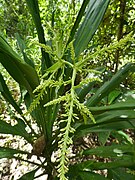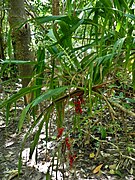
Floydia is a monotypic genus of plants in the macadamia family Proteaceae which is endemic to Australia. The sole described species is Floydia praealta, commonly known as the ball nut. It is a somewhat rare tree found only growing in the rainforests of southeastern Queensland and northeastern New South Wales. The tree has a superficial resemblance to the closely related Macadamia and could be confused with them. The fruit of F. praealta is poisonous.
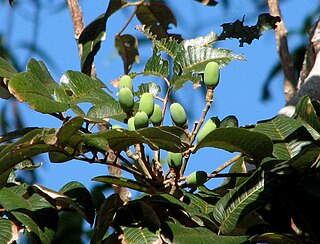
Canarium australianum, commonly known as scrub turpentine, is a species of tree in the family Burseraceae native to Australia and Papua New Guinea. Other common names include mango bark, carrot wood, parsnip wood, Melville Island white beech and brown cudgerie.

Atractocarpus chartaceus, commonly known as the narrow-leaved gardenia, is a species of evergreen flowering plant in the madder and coffee family Rubiaceae. It is mostly found in subtropical rainforest of eastern Australia, and it is cultivated for its fragrant flowers and colourful fruit.

Phaleria clerodendron, commonly known as scented daphne, scented phaleria or rosy apple, is an evergreen tree or tall shrub in the family Thymelaeaceae. It is endemic to the rainforests of north-eastern Queensland, Australia.

Leionema elatius, commonly known as tall phebalium, is a shrub species that is endemic to New South Wales and Queensland in Australia. It has glossy green, variably-shaped leaves and clusters of white-lemon flowers in spring.

Buckinghamia celsissima, commonly known as the ivory curl tree, ivory curl flower or spotted silky oak, is a species of tree in the family Proteaceae. It is endemic to the tropical rainforests of northeastern Queensland, Australia.

Palmeria scandens, commonly known as the anchor vine or pomegranate vine, is a climbing plant in the family Monimiaceae prevalent in rainforests of Queensland and New South Wales. It may also be present in New Guinea.

Atractocarpus hirtus, commonly known as the hairy gardenia or native loquat, is a plant in the coffee family Rubiaceae, a large family of some 6,500 species with a cosmopolitan distribution. This species is endemic to northeastern Queensland, Australia.
Cryptocarya mackinnoniana is a species of tree in the Lauraceae family. Growing up to 25m in size, it is found in well developed rainforests from the Iron Range area on Cape York Peninsula south to Paluma in North Queensland, Australia. It was first botanically described by Ferdinand von Mueller in Fragmenta Phytographiae Australiae 5: 169 (1865).

Mackinlaya macrosciadea, commonly known as mackinlaya or blue umbrella, is a plant in the carrot, fennel and parsley family Apiaceae, found in the Northern Territory and Queensland, Australia.
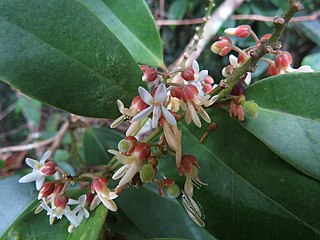
Xanthophyllum octandrum, commonly known as Macintyre's boxwood, false jitta, yellow boxwood or sovereignwood, is a slow-growing tree in the milkwort family Polygalaceae which has the potential to reach thousands of years of age. It is endemic to coastal northeastern Queensland, Australia.

Alpinia arctiflora, commonly known as the pleated ginger, is a plant in the ginger family Zingiberaceae which is endemic to northeastern Queensland.

Archidendron vaillantii, commonly known as the salmon bean, is an evergreen tree in the legume family Fabaceae. It is endemic to the rainforests of northeast Queensland.

Benstonea monticola, commonly known as scrub breadfruit or urchin-fruited pandan, is a plant in the family Pandanaceae which is endemic to rainforested parts of north east Queensland, Australia.

Fagraea fagraeacea, commonly known as yellowheart or pink jitta, is a plant in the gentian family Gentianaceae which is native to New Guinea and Queensland.

Atractocarpus sessilis, commonly known as brown randia, is an evergreen shrub in the family Rubiaceae. It is native to both Queensland, Australia, and Papua New Guinea (PNG).
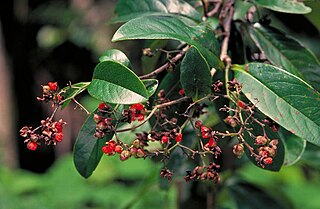
Tetracera daemeliana, commonly known as large-leaved fire vine, is a vine in the guinea flower family Dilleniaceae first described in 1886, which is endemic to the northern half of Queensland, Australia. The flowers are pleasantly perfumed.

Gillbeea adenopetala, commonly known as Pink alder, is an evergreen tree in the largely southern hemisphere family Cunoniaceae. It was first described in 1865 and is endemic to a small part of Queensland, Australia.

Buchanania mangoides, commonly known as plum tree, is a plant in the mango and cashew family Anacardiaceae native to Queensland, Australia. It was first described in 1869.

Mackinlaya confusa is a plant in the carrot, fennel and parsley family Apiaceae that is endemic to Queensland, Australia. It was first described in 1909.


